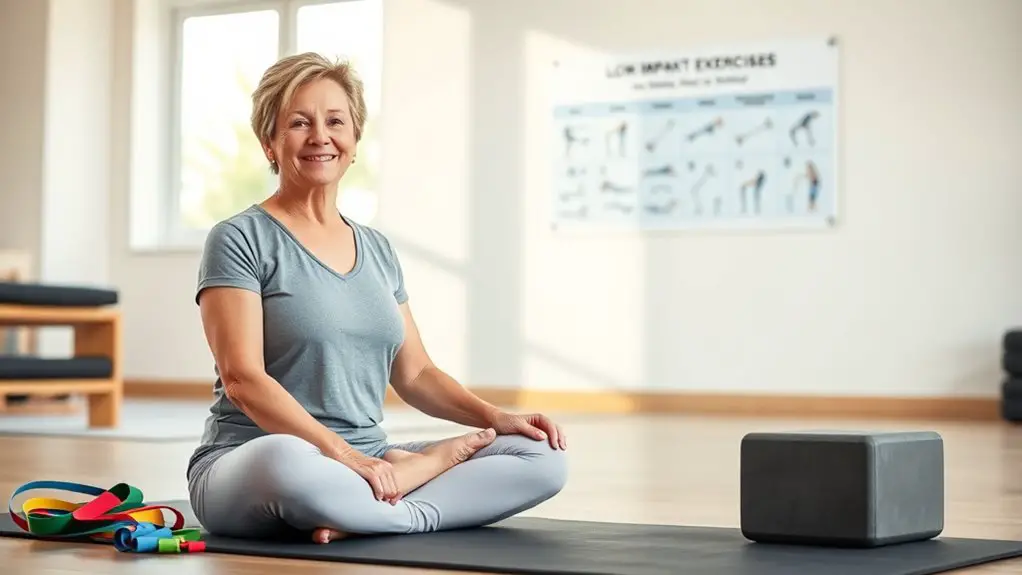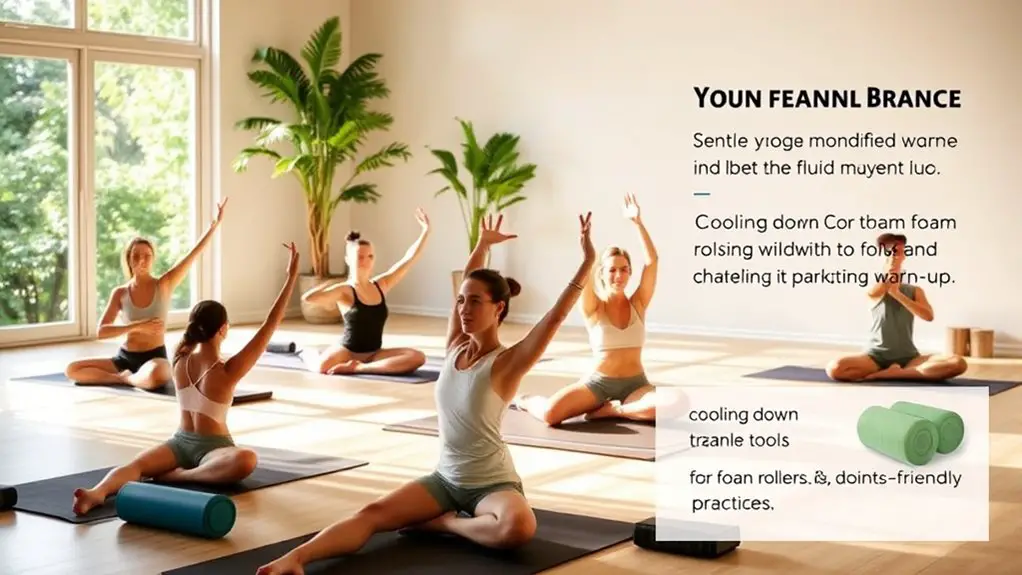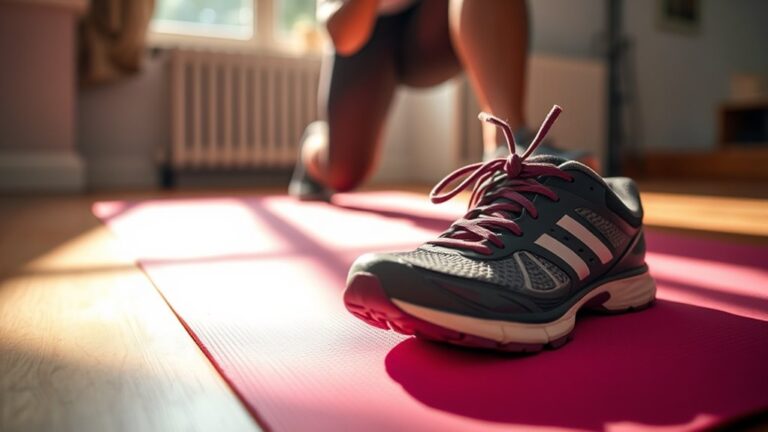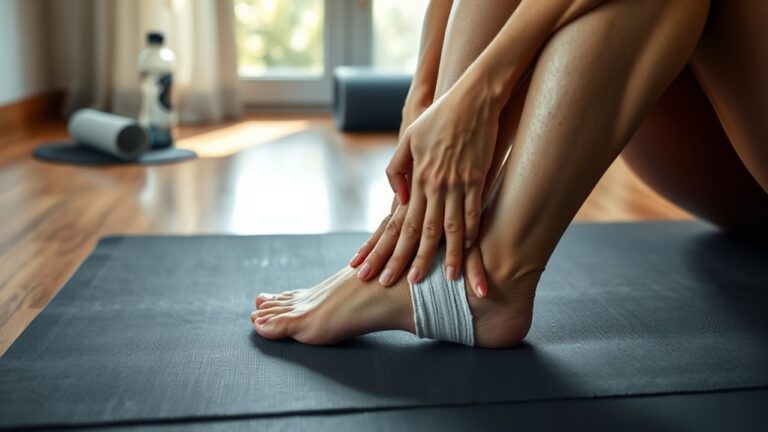How to Modify Workouts for Joint Pain and Stiffness

To modify workouts for joint pain and stiffness, focus on low-impact activities like water aerobics or cycling to ease joint stress. Always start with a dynamic warm-up and end with gentle stretches to enhance flexibility. Use lighter weights and controlled movements during strength training to avoid strain. Listen to your body; adjust intensity or take breaks as needed. Incorporating rest days and seeking guidance from a professional can help tailor a plan that supports your fitness goals. More insights await.
Understanding Joint Pain and Its Impact on Exercise

When you experience joint pain, it can greatly affect your ability to engage in physical activity. Understanding the causes of pain, such as arthritis, tendinitis, or injuries, is essential for effective pain management. These conditions can lead to inflammation, stiffness, and a decrease in range of motion, making conventional exercises challenging.
It’s important to recognize how joint pain impacts your daily routine, potentially leading to decreased mobility and overall fitness. Adapting your workout regimen becomes critical for maintaining an active lifestyle.
You might consider integrating strategies like warm-ups, stretching, and strength training to support your joints. Additionally, working with healthcare professionals can help tailor a pain management plan that suits your specific needs. Remember, addressing joint pain doesn’t mean giving up on exercise; it means finding the right approach to stay active and healthy while minimizing discomfort. Skipping rope is an activity that can improve coordination and balance, which may be beneficial for individuals with joint pain.
Choosing Low-Impact Activities
If you’re dealing with joint pain, choosing low-impact activities can considerably reduce discomfort while allowing you to stay active. One effective option is water aerobics, which offers numerous benefits. The buoyancy of water supports your body, alleviating pressure on your joints while enabling a full range of motion. This makes water aerobics a safe and enjoyable way to strengthen muscles and improve cardiovascular fitness without added strain.
Cycling is another excellent choice, providing significant advantages for those with joint issues. Whether using a stationary bike or cycling outdoors, this activity promotes joint flexibility and builds endurance with minimal impact. By focusing on these low-impact exercises, you can maintain an active lifestyle while managing your joint pain effectively. Remember to listen to your body and adjust the intensity as needed, ensuring you engage in activities that enhance your well-being without exacerbating discomfort.
Warming Up and Cooling Down Properly

Although you may be enthusiastic to plunge into your workout, taking the time to warm up and cool down properly is essential for managing joint pain. Dynamic warm ups help prepare your body for exercise by increasing blood flow and enhancing flexibility, reducing the risk of injury. Focus on gentle movements that engage the joints and muscles you’ll be using. Additionally, warming up can help prevent lower back pain associated with high-impact activities like skipping rope.
After your workout, static cool downs are vital. These help lower your heart rate and promote recovery. Engaging in gentle stretches allows your muscles and joints to relax, alleviating stiffness.
Here’s a quick reference table for effective warm-up and cool-down exercises:
| Warm-Up Exercises | Duration | Cool-Down Exercises |
|---|---|---|
| Arm Circles | 5 mins | Forward Bends |
| Leg Swings | 5 mins | Seated Hamstring Stretch |
| Walking Lunges | 5 mins | Quadriceps Stretch |
| Torso Twists | 5 mins | Child’s Pose |
Strength Training Modifications
To effectively manage joint pain during strength training, it’s important to modify your approach without sacrificing the benefits of resistance exercises. Implementing specific strength training adaptations can help you maintain your fitness while minimizing discomfort. Consider the following strategies:
- Resistance level adjustments: Start with lighter weights to gauge your comfort and gradually increase as tolerated.
- Focus on form: Prioritize proper technique to avoid unnecessary strain on joints, emphasizing controlled movements.
- Incorporate variations: Utilize machines or resistance bands instead of free weights to reduce joint impact.
Flexibility and Stretching Techniques

Incorporating gentle stretching exercises into your routine can greatly enhance flexibility and reduce joint discomfort. It’s essential to prioritize warm-up activities to prepare your muscles and joints for movement, minimizing the risk of injury. By focusing on these techniques, you’ll create a safer and more effective workout environment tailored to your needs. Regular stretching increases flexibility, which is crucial for maintaining joint health and enhancing overall performance in physical activities.
Gentle Stretching Exercises
When you’re dealing with joint pain, gentle stretching exercises can be essential for maintaining flexibility and reducing discomfort. Incorporating these movements into your routine can help alleviate stiffness and improve your overall mobility. Consider these techniques:
- Yoga poses: Simple poses like Cat-Cow and Child’s Pose promote gentle stretching and relaxation.
- Foam rolling: This technique helps release tension in tight muscles, improving blood flow and flexibility.
- Focus on breath: Deep, controlled breathing during stretches can enhance relaxation and effectiveness.
Always listen to your body and avoid any movements that cause pain. It’s important to ease into these exercises gradually, ensuring you’re supporting your joints while enhancing your flexibility. Your commitment to gentle stretching can lead to significant improvements in your comfort and mobility.
Warm-Up Importance
Gentle stretching exercises lay a strong foundation for the importance of warming up before any physical activity, especially for those experiencing joint pain. Incorporating dynamic stretching and mobility drills can greatly enhance your range of motion and prepare your joints for exercise. Dynamic stretching involves controlled movements that gently increase your heart rate and flexibility, while mobility drills focus on joint function and stability. By prioritizing these techniques, you not only reduce the risk of injury but also improve overall workout effectiveness. Remember to listen to your body; if something feels uncomfortable, modify the movement or seek alternatives. A proper warm-up routine tailored to your needs can make a remarkable difference in your fitness journey while managing joint discomfort.
Utilizing Supportive Equipment
When managing joint pain, choosing the right supportive equipment can make a significant difference in your workouts. Tools like braces, supportive footwear, and cushioned mats not only enhance comfort but also help prevent further injury. Understanding the benefits of these aids will empower you to engage in physical activity more safely and effectively.
Choosing the Right Gear
Choosing the right gear is essential for managing joint pain during workouts, as improper equipment can exacerbate discomfort and hinder your progress. Investing in quality items can make a significant difference in your comfort and performance.
Consider these essentials:
- Proper footwear: Ascertain your shoes provide adequate arch support and cushioning to absorb impact.
- Supportive apparel: Look for clothing that offers compression and flexibility, helping to stabilize joints while allowing for a full range of motion.
- Assistive devices: Utilize items like knee braces or wrist supports to alleviate strain during specific exercises.
Benefits of Supportive Tools
Supportive tools can greatly enhance your workout experience, especially if you’re dealing with joint pain. Utilizing supportive equipment like bracing techniques can stabilize your joints, reducing discomfort during exercise. For instance, knee or ankle braces can provide essential support, allowing you to focus on your workout rather than your pain.
Additionally, investing in supportive footwear is vital. Proper shoes can absorb shock, distribute weight evenly, and minimize impact on your joints. This makes a significant difference, whether you’re walking, running, or engaging in low-impact activities. By integrating these supportive tools into your routine, you can maintain your fitness goals while protecting your joints, ultimately enhancing your overall wellbeing and workout effectiveness.
Listening to Your Body

Listening to your body is essential, especially when managing joint pain during workouts. Your body’s signals are significant indicators of how you’re responding to exercise. Ignoring these signals can lead to further discomfort or injury. Pay attention to the following:
- Pain Level: If you experience sharp or persistent pain, it’s a sign to modify your workout.
- Fatigue: Overexertion can exacerbate joint issues. Rest or reduce intensity when needed.
- Range of Motion: If movements feel restricted, consider adjusting your exercises to accommodate your current mobility. Regular exercise promotes blood flow and reduces knee inflammation, ultimately improving joint function.
Incorporating Rest and Recovery
Incorporating rest and recovery into your routine is essential for managing joint pain and enhancing overall performance. Rest days allow your body to heal, while active recovery techniques can help maintain mobility without adding stress to your joints. Additionally, prioritizing quality sleep plays a vital role in the healing process, ensuring you’re ready to engage in your workouts effectively.
Importance of Rest Days
While it’s tempting to push through workouts, prioritizing rest days is vital for managing joint pain and promoting overall recovery. Rest days provide significant rest day benefits, allowing your body to repair and strengthen. When you give your joints a break, you reduce inflammation and prevent further damage.
Here are some key recovery techniques to reflect on during your rest days:
- Muscle repair: Your muscles need time to recover, which strengthens them and enhances performance.
- Joint health: Rest allows inflammation to decrease, improving joint function and reducing pain.
- Mental well-being: Taking breaks helps prevent burnout and keeps you motivated to continue your fitness journey.
Incorporating rest days into your routine is essential for long-term health and effective workout management.
Active Recovery Techniques
Rest days are important, but incorporating active recovery techniques can further enhance your joint health and overall recovery. Active recovery includes low-intensity activities like walking, swimming, or yoga—practices that promote blood circulation without stressing your joints. These restorative practices help maintain flexibility, improve range of motion, and reduce stiffness. Engaging in light activities can also alleviate muscle soreness and promote the healing process. It’s vital to listen to your body; if you feel discomfort, modify the intensity or duration. Remember, the goal is to support your joints while allowing them to recover. By integrating active recovery into your routine, you’re not just resting—you’re actively fostering long-term joint health and resilience.
Sleep and Healing Process
Getting enough quality sleep is essential for the healing process, especially if you’re dealing with joint pain. Your body needs restorative sleep to repair tissues and reduce inflammation. To improve your sleep quality and create a supportive healing environment, consider the following:
- Maintain a consistent sleep schedule to regulate your body’s internal clock.
- Create a calming bedtime routine to signal your body it’s time to wind down.
- Make certain your sleeping space is comfortable, dark, and cool to promote restful sleep.
Working With a Professional Trainer
When you’re dealing with joint pain, collaborating with a professional trainer can greatly enhance your workout experience and outcomes. A skilled trainer can assess your specific needs and create personalized programs that accommodate your limitations while still promoting strength and flexibility. This trainer collaboration is essential, as it guarantees that exercises are tailored to your condition, minimizing the risk of injury and maximizing effectiveness.
Trainers can also teach you proper techniques, which helps reduce strain on your joints. They’ll monitor your progress and make necessary adjustments, confirming that you stay on track without exacerbating your pain. Furthermore, having a professional by your side can provide much-needed support and encouragement, making your fitness journey more manageable. Remember, investing in a knowledgeable trainer can considerably improve your chances of achieving your fitness goals while managing joint discomfort effectively.
Staying Motivated and Setting Realistic Goals

Working with a professional trainer can lay a solid foundation for your fitness journey, but maintaining motivation and setting realistic goals are equally important for long-term success. To stay on track, utilize effective motivation techniques and focus on goal setting that accommodates your unique needs.
- Break larger goals into smaller, achievable milestones.
- Track your progress regularly to celebrate victories, no matter how small.
- Surround yourself with supportive individuals who encourage your journey.
Frequently Asked Questions
Can Certain Foods Help Reduce Joint Pain During Workouts?
Certain foods can indeed help reduce joint pain during workouts. Incorporating anti-inflammatory foods like berries, fatty fish, and leafy greens into your diet can be beneficial. These foods may help alleviate inflammation and promote overall joint health. Additionally, don’t underestimate hydration’s importance; staying well-hydrated can help maintain joint lubrication and function. By focusing on these dietary choices, you can support your body and enhance your workout experience while managing joint discomfort effectively.
How Do I Know if I’m Overdoing It?
Think of your body as a finely tuned machine; if it starts to sputter, it’s time to check in. You’ll know you’re overdoing it when you experience pain indicators like sharp aches or persistent soreness. These signals often mean you’ve crossed your workout limits. Pay attention to how your body feels, and don’t ignore discomfort. Adjust your routine accordingly, and remember, it’s always better to take a step back than to push through pain.
Are There Specific Supplements for Joint Health?
When considering supplements for joint health, glucosamine sulfate and omega 3 fatty acids are often recommended. Glucosamine sulfate may help support cartilage repair and reduce pain, while omega 3 fatty acids are known for their anti-inflammatory properties, which can alleviate joint discomfort. It’s important to consult with a healthcare professional before starting any new supplement regimen, as they can provide personalized advice based on your specific health needs and conditions.
What Are the Best Shoes for Joint Support?
When you’re looking for the best shoes for joint support, focus on key shoe features like cushioning and stability. Look for footwear that offers ample arch support, as this can help distribute weight evenly and reduce strain on your joints. Additionally, consider shoes with shock-absorbing soles, which can minimize impact during activities. By selecting the right shoes, you can enhance your comfort and potentially alleviate joint discomfort during daily movements.
How Can I Modify Cardio Workouts for Joint Pain?
Did you know that nearly 40% of adults experience joint pain? To modify your cardio workouts, consider low-impact alternatives like swimming, cycling, or walking on softer surfaces. These options reduce stress on your joints while still providing cardiovascular benefits. Incorporating gentle exercises, such as yoga or tai chi, can also improve flexibility and strength. Always listen to your body, and consult a healthcare professional before making significant changes to your routine.





